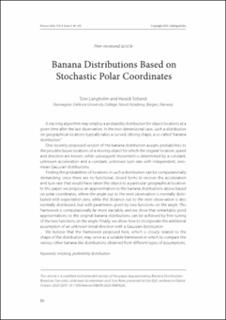Banana Distributions Based on Stochastic Polar Coordinates
Peer reviewed, Journal article
Permanent lenke
https://hdl.handle.net/11250/2832592Utgivelsesdato
2021Metadata
Vis full innførselSamlinger
- Artikler [251]
Sammendrag
A tracking algorithm may employ a probability distribution for object locations at a given time after the last observation. In the two-dimensional case, such a distribution on geographical locations typically takes a curved, oblong shape, a so-called “banana distribution.” One recently proposed version of the banana distribution assigns probabilities to the possible future locations of a moving object for which the original location, speed and direction are known, while subsequent movement is determined by a constant, unknown acceleration and a constant, unknown turn rate with independent, zero-mean Gaussian distributions. Finding the probabilities of locations in such a distribution can be computationally demanding, since there are no functional, closed forms to recover the acceleration and turn rate that would have taken the object to a particular geographical location. In this paper we propose an approximation to the banana distributions above based on polar coordinates, where the angle out to the next observation is normally distri buted with expectation zero, while the distance out to the next observation is also normally distributed, but with parameters given by two functions on the angle. This framework is computationally far more tractable, and we show that remarkably good approximations to the original banana distributions can be achieved by fine-tuning of the two functions on the angle. Finally, we show how to incorporate the additional assumption of an unknown initial direction with a Gaussian distribution. We believe that the framework proposed here, which is closely related to the shape of the distribution, may serve as a suitable framework in which to compare the various other banana-like distributions obtained from different types of assumptions.
